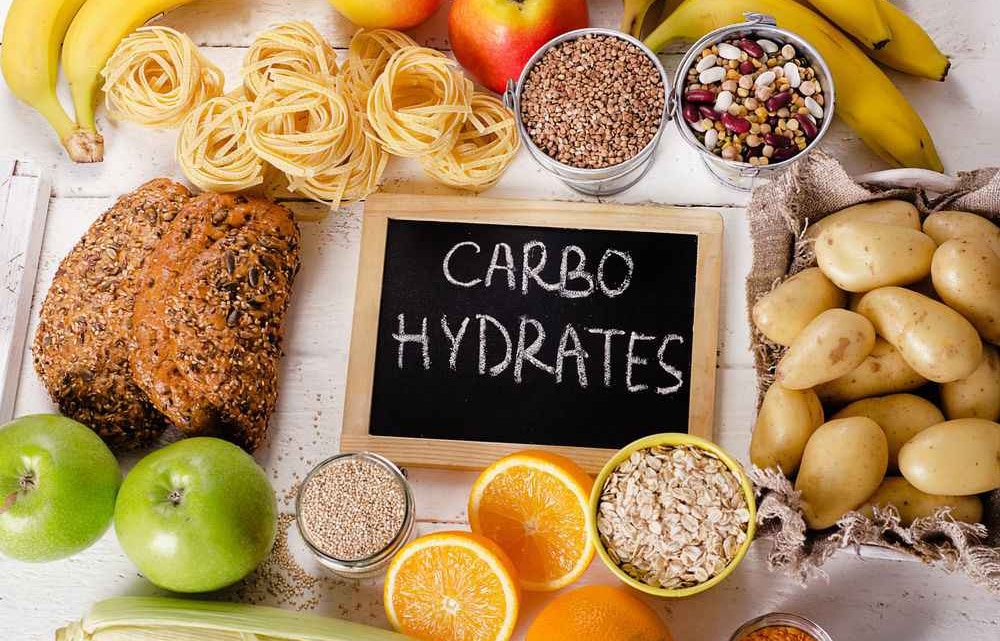Use our carb cycling calculator to accelerate weight/fat loss and reach your goals faster…
Carbohydrates, along with protein and fat, are macronutrients that must be consumed in large quantities to sustain basic life functions. But carbs are mainly responsible for supplying the body with energy and 1g contains about 4 calories.
Quality carbs are an essential part of a balanced nutritional regime but it’s one macronutrient that is most often adjusted in the diet when the goal is weight loss, physical performance, and even overall health. But today, we’re going to talk about carb cycling or alternating carbohydrate intake for weight loss…
What is Carb Cycling?
Carb cycling involves manipulating carbohydrate intake to provide the body with adequate fuel for certain activities but also minimize carb intake when the body doesn’t need as much of it.
It’s common to cycle on a daily, weekly, or even monthly basis depending on the goal. [1]
Here are a few reasons why one may choose to carb cycle…
- Limit fat gain – Carbs supply the body with energy but if too much is consumed and not used up during physical activity, the body can store it as fat. That’s why people consume more carbs on training/active days, and fewer calories on less active days.
- Weight/fat loss – You either lose or gain weight depending on your overall macronutrient intake. But carbs are typically the macronutrient that’s most often adjusted as it can play a significant role in body composition.
- Improved/longer performance – The longer and more intense a physical activity, the more carbohydrates will be needed to fuel the session as your body needs glycogen stores to tap into in order to sustain the activity.
- Competition/special occasions – Bodybuilders tend to carb cycle and carb load prior to a competition to fill out the muscles. But this method can be used by anyone to achieve the same effect.
- Overall health – Carbohydrates can greatly affect blood sugar and insulin levels. Insulin is the hormone that helps the body to transport glucose/energy to the blood.
Fat is the other macronutrient commonly adjusted to accommodate the lack of or abundance of carbs as fat is also a source of energy although it’s important for other bodily functions as well. But fat is higher calorie (about 9 calories per gram) which is why you really have to know how much of each macronutrient you’re consuming on a daily basis.
Protein is usually kept moderate to high as it’s the macronutrient that builds muscle tissue which is needed in sufficient amounts even in an energy deficit where the goal is losing weight/cutting.
Carbs play a role in many processes of the body and as you’ve probably guessed by now but there are certainly benefits to cycling between low and moderate/high carb intake.

Hunger
Carb cycling can contribute to hunger hormone (ghrelin and leptin) regulation, therefore, contributing to more weight loss. And research shows that a high-protein and high-fat meal has a more favorable postprandial satiety and appetite hormonal response when compared to a high-carb meal. [2, 3, 4, 5]
Glycogen replenishment and insulin health
Glucose is important for maximally restoring glycogen levels in the muscles in combination with protein as both act synergistically on insulin secretion. This is why it’s ideal to consume more carbs on the days you’re more active.
But speaking of insulin, one study found that just a modest reduction in carbs has positive effects on glucose metabolism, in addition to fat distribution, and body composition. [7]
This is useful information for overweight/obese individuals and those with Type 2 diabetes. Although extreme dieting is not recommended and advice from a medical professional should always be sought prior to attempting to self treat any serious health condition.
Burn more fat
Another benefit of carb cycling is that low carb, moderate to high fat days allow the body to burn fat more efficiently as it becomes the more prominent energy source. This is otherwise known as ketosis where the body produces ketones in the blood which are often referred to as ‘super fuel‘. [8]
But this is typically achieved when daily carb intake is 50g or less.
Now, we could all agree that the average American’s diet is carb-heavy with all of the delectable goodies. But cutting out carbs can also drastically reduced overall calories consumed which can help big time with losing weight. Although, this goes for any of the macronutrients as well. [9]
It’s also important to note that the hormone insulin stores fat in the body but a low-carb diet can actually lower insulin levels which allows for the body to more easily utilize these fat stores.
This is also why you tend to lose water on a low-carb diet as well because it causes your kidneys to rid excess water. [10, 11]
Performance
Carbs are also very important for physical performance such as high-intensity training and short duration run performance according to one scientific review where subjects underwent testing. [12]
In fact, while protein and fats can be a viable source of energy in some instances, carbs are the only macronutrient that can be broken down quickly enough to sustain maximal performance during high-intensity activities according to one 2018 scientific review. [12]
Other benefits of manipulating carb intake are improved cholesterol (raises HDL and improves LDL) and research shows low-carb diets are as effective as low-fat diets for weight loss and metabolic risk factors. [13, 14]
Example Carb Cycling Routine
There’s no one-size-fits-all formula when it comes to anything related to diet and nutrition. Well, carb cycling is certainly not an exception.
But there are a few different ways to implement carb cycling which will be dependant on goals.
Here’s an example weekly routine…
Day 1: Weight training – high carb, low fat
Day 2: Active recovery/ cardio – moderate carb, moderate fat
Day 3: Weight training – high carb, low fat
Day 4: Weight training – high carb, low fat
Day 5: Rest – low carb, high fat
Day 6: Weight training – high carb, low fat
Day 7: Rest – low carb, high fat
Of course, this can be manipulated based on your actual schedule. But you can also do high or low carb for as long as you want and then switch it up once in a while based on how you feel, your lifestyle, and how you’re progressing.
Low-carb days (not keto) typically consist of anywhere from 50-150 grams whereas higher-carb days can consist of anywhere from 130-400+ grams per day. But again, there are several factors that will determine an appropriate daily carb intake.
Good Carb Sources To Eat
High carb days and most of your carb consumption should consist of healthy, nutritious food sources that provide quality, complex (slow-digesting) carbs in addition to a few fast-digesting carbs like some fruits too. Good carbs provide lasting energy sure but they also provide necessary vitamins and minerals, plus fiber to support digestion and bowel health.

But if you’re not sure which foods are best for your goals then here’s a list of quality options…
- Vegetables (leafy greens, cauliflower, carrots)
- Tubers (sweet potatoes, potatoes)
- Grains (oats, rice, quinoa)
- Fruits (berries, bananas, apples, kiwis)
- Legumes (chickpeas, lentils, black beans)
There are, of course, more options but these foods are nutritious and healthy for your fitness goals. Low carb days should consist of more non-starchy carbs such as greens, onions, tomatoes while the high carb days can consist of starchy carbs like potatoes, legumes, corn, etc.
How To Use The Carb Cycling Calculator
Here’s a step-by-step for using the carb cycling calculator…
- Choose your gender
- Type in your age, weight, and height
- Select your activity factor from the dropdown (Choosing BMR implies you’re mostly sedentary)
- Choose whether or not you’re sensitive to carbs
- Choose your fat loss goal
You’ll then get your results which includes your basal metabolic rate (calories burned at rest) and a carb cycling routine with recommended calories and macronutrients that you can use which is based on the 7-day week.
And that’s pretty much it. You have the knowledge and now the tools to hopefully benefit from a carb cycling regime and feel free to adjust as needed according to your progress and goals.
Other similar Calculators
- TDEE Calculator
- Intermittent Fasting Calculator
- Weight Gain Calculator
- Macro Calculator
- Body Fat Calculator
Frequently Asked Questions
What is carb cycling?
It’s basically manipulating your carb intake in alternating fashion with the goal of achieving a certain outcome.
For example, if your goal is weight loss, you’ll want to alternate high and low carb days in a way that optimally allows you to benefit from the weight loss effects of low-carb dieting while also supplying the body with sufficient carbs on more active days.
What's the best way to carb cycle?
There are many different ways to do carb cycling and there’s no single formula that will work best for everyone. But you can follow a basic, weekly carb cycling routine for a few weeks and see how it works for you. This way, you can make any necessary adjustments based on how you feel, your goal/s, and how your body responds.
This is where the carb cycling calculator comes in handy because it does most of the work for you and gives you a plan to follow.
What are the best foods to eat when carb cycling?
You always want to make healthy, nutritious foods a main part of your diet. But you want to make sure you’re accurately tracking your carb intake to ensure your eating the right amounts of each food.
Here are some smart carb choices…
- Vegetables (leafy greens, cauliflower, carrots)
- Tubers (sweet potatoes, potatoes)
- Grains (oats, rice, quinoa)
- Fruits (berries, bananas, apples, kiwis)
- Legumes (chickpeas, lentils, black beans)
What are the benefits of carb cycling?
Cycling carbohydrate intake can limit fat gain, increase fat loss, improve metabolic risk factors, insulin, and cholesterol, in addition to maximizing physical performance.
Can carb cycling cause side effects?
Changes in carbohydrate intake can result in feelings of dizziness, headache, trouble sleeping, mood changes, irritability, lack of energy, constipation, etc.
However, this varies between individuals and for most people, these side effects tend to subside after a week or so once a normal routine is established and overall nutrition is sufficient to support healthy functioning.

